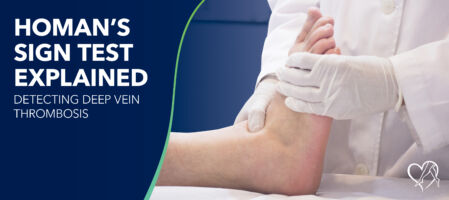
Have you ever felt unexplained leg pain, swelling, or discomfort and wondered if it could be a sign of something serious? Many people are unaware that such symptoms could be linked to deep vein thrombosis (DVT), a severe condition where blood clots form in the deep veins of the legs. Left untreated, DVT can lead to dangerous complications, including pulmonary embolism (a life-threatening blockage in the lungs).
To help detect the presence of DVT, doctors may use a physical examination method known as the Homan’s Sign Test.
In this blog, we'll explore the Homan’s Sign Test, how it’s performed, and what it can tell you about your vein health. Understanding this test and its implications can help you take proactive steps to protect your health, especially if you’re at risk of DVT or other vein problems.
The Homan’s Sign Test is a simple, noninvasive test used to help detect deep vein thrombosis (DVT). Named after American physician John Homan, it has been used for decades by doctors to assess patients with leg pain or swelling—two classic symptoms of DVT.
During the test, a healthcare provider will gently dorsiflex your foot (bend your foot upward toward the shin) while keeping your knee straight. If this motion causes pain or discomfort in your calf, it may indicate a positive Homan’s sign. This response can suggest the presence of a blood clot in the deep veins of your leg, though it’s important to remember that this test alone isn’t definitive.
While the Homan’s Sign Test may be a valuable tool in a pinch, it’s not reliable on its own. Many vein experts agree that a positive Homan’s sign doesn’t necessarily mean a person has DVT, and a negative result doesn’t guarantee that they don’t. A study published in ScienceDirect concludes that the test is neither a sensitive nor specific test for DVT and “has fallen out of favor.”
According to the National Library of Medicine (NIH), the test has proven unreliable, as studies show it lacks sensitivity and specificity. More accurate diagnostic tools, such as compression ultrasonography and venography, are now preferred for detecting DVT. Despite its limitations, the Homan's sign remains of historical interest in the evolution of DVT diagnostics.
Vein specialists today use more advanced tools, such as Duplex ultrasonography or D-dimer test, to rule out DVT. However, if you’re experiencing leg pain or swelling, a doctor may still use this test as a quick way to help determine if further investigation is necessary.
Important health warning: Blood clots can be life-threatening, so early diagnosis and treatment are crucial. At Center for Vein Restoration (CVR), we've streamlined the process of diagnosing and treating DVT by offering same-day DVT-rule-out services, eliminating the need for an expensive, time-consuming trip to the emergency room.
If you suspect a blood clot, time is of the essence! To schedule a DVT rule-out for yourself or a loved one, call our hotline at 877-SCAN-DVT (877-722-6388).
A positive Homan’s sign may prompt your doctor to investigate further for DVT, especially if you’re experiencing common DVT symptoms, which include:
If you notice any of these DVT signs, it is essential to see a vein specialist as soon as possible. Contact the Center for Vein Restoration’s DVT rule-out service hotline at 877-SCAN-DVT (877-722-6388).
Venous insufficiency, a condition in which veins struggle to send blood from the legs back to the heart, can significantly increase the risk of DVT. According to research published in the Journal of Vascular Surgery: Venous and Lymphatic Disorders, individuals with primary venous insufficiency are more likely to develop blood clots in the deep veins. This is due to the pooling of blood in the lower extremities, which promotes clot formation.
Managing venous insufficiency through early treatment can help reduce the risk of DVT, making it crucial for those with vein disease to monitor their venous health closely.
Other risk factors that can increase your risk of developing DVT include:
If you’re experiencing leg pain, swelling, feelings of leg fatigue, or heaviness –or fall into any of the above high-risk groups, it’s important to talk to a board-certified vein expert. At Center for Vein Restoration, our caring vein specialists use advanced tools to diagnose and treat vein conditions using minimally invasive outpatient procedures so you can feel better and get back to your life quickly.

While the Homan’s Sign Test can offer some rudimentary clues, only advanced diagnostic tests can accurately diagnose DVT. Ultrasound and D-dimer blood tests remain the gold standard for detecting blood clots in the legs. These tests provide a more definitive answer and guide treatment decisions than the Homan's sign test.
Center for Vein Restoration is proud to offer same-day DVT rule-out services, ensuring that you receive fast, accurate care when you need it most. Our team of experienced vein specialists is here to support you, from diagnosis to vein treatment, ensuring your health is in safe hands. Call our DVT rule-out service hotline at 877-SCAN-DVT (877-722-6388) to schedule an appointment.
If you're experiencing symptoms like leg pain, swelling, or tenderness, it could be related to DVT or another vein problem. Don’t wait to seek help. Early detection of vein diseases is key to preventing complications.
At Center for Vein Restoration (CVR), we are the industry leaders in diagnosing and treating vein disorders, including varicose veins, spider veins, restless leg syndrome, and deep vein thrombosis (DVT). With a nationwide network of highly skilled physicians and state-of-the-art technology, we’re committed to providing exceptional care to improve your vein health and quality of life.
Call 240-965-3915 to speak to a Patient Services Representative or schedule your consultation online at a CVR near you today.
